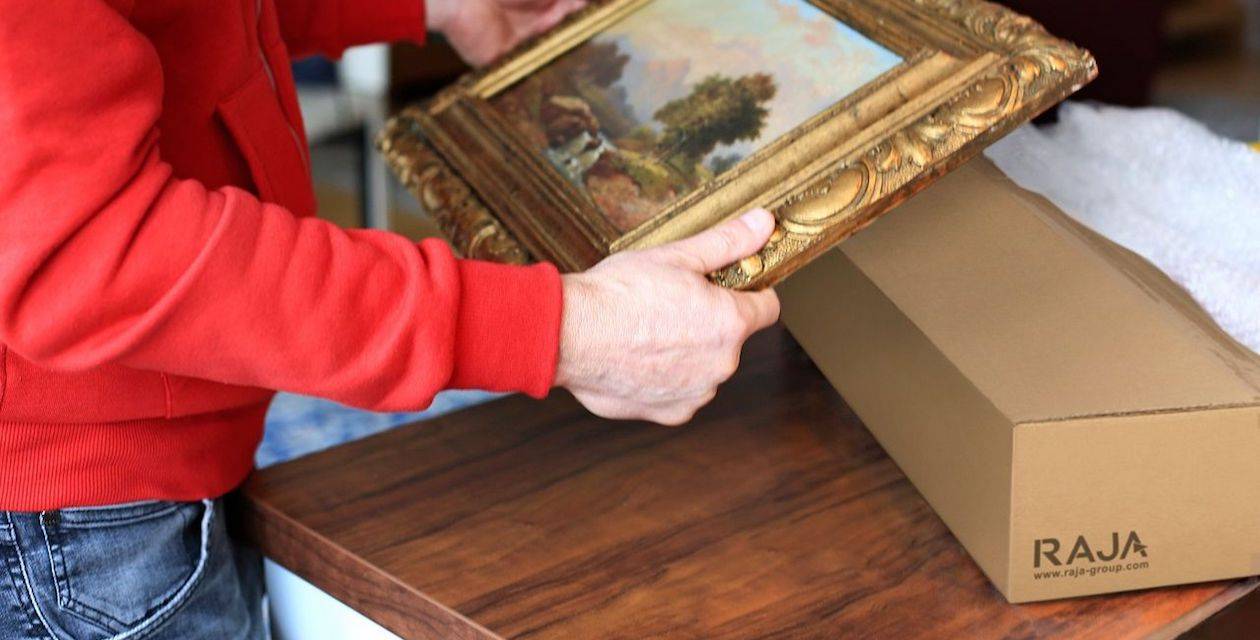Déplacer une œuvre d’art n’est pas une mince affaire. Non seulement, vous devez vous assurer que celle-ci arrive à destination en excellent état, mais son transit (notamment en cas de transport international) peut être régulé par des réglementations spécifiques.
C’est pour vous aider à assurer un envoi d’œuvre d’art sans accroc que nous avons conçu ce petit guide, où vous trouverez les emballages et les solutions de transport adaptées à ce type de marchandise.
Que vous soyez un particulier ou que vous travailliez pour un musée ou une galerie d’art, vous aurez entre les mains toutes les clés pour expédier vos œuvres en toute sérénité !

Quels emballages pour les œuvres d’art ?
Transporter une œuvre d’art, quelle qu’elle soit, dans les bonnes conditions, c’est avant tout opter pour les solutions d’emballage qui permettent à votre produit d’arriver dans les meilleures conditions entre les mains du destinat
 |
Bubble wrapa classic in art packaging, which effectively cushions shocks. |
 |
Kraft paperevertrans In’Art Transport is an environmentally friendly packaging alternative for environmentally friendly parcels. |
 |
Tissue paperthe soft and elegant art wrap is available in a variety of colours to enhance your artwork when the package is opened. |
 |
Polyethylene foam sheetsyou can also use these sheets to pad the inside of a crate where you place several framed paintings. |
 |
Tyvek filmthis is the softest and most secure padding available for shipping artworks. |
for the next step, install cardboard or foam corners around the frame of your painting. If you then slip your frame into a package that is larger than its size, don’t hesitate to use protective adhesive pads, which are positioned in the crate to avoid direct shocks to the product during transport. Then comes the time to select a package specifically made for framed paintings, which corresponds as closely as possible to the size of your work of art
 |
Postal cross caseit is very protective thanks to its cardboard edges and can be adjusted in height to fit the thickness of the frame you wish to pack. |
 |
Flat brown telescopic boxthe art box, which can be adjusted in height from 50 to 200 cm, is made of a highly protective double-fluted cardboard and a cover that ensures that the artwork is sent in total security. |
 |
Cardboard box with foamis ideal for large format fragile products, thanks to its integrated anti-shock and anti-scratch foam. |
 |
Triple fluted cardboard boxthe large, triple-fluted box is also available, which can be useful if your framed painting is very large, or if you are packing several works of art at the same time. Be sure to secure the product inside with a suitable cushioning material. |
 |
Wooden cratethis product is suitable for very expensive or fragile works of art, for maximum protection. |
finally, finish off by wrapping your package with plastic stretch film to make it moisture resistant and as compact as possible. If you want to keep the contents of your package discreet, you can opt for black plastic film. If you are committed to an environmentally responsible image above all, wrap it in biobased and recyclable kraft paper
 important: Whatever the work of art you are sending, make sure you always apply an adhesive label marked “fragile”, to guide the handling during the transport phase important: Whatever the work of art you are sending, make sure you always apply an adhesive label marked “fragile”, to guide the handling during the transport phase |
you can also choose adhesives with other messages
packaging for a frameless painting or photograph (that can be rolled up)
If your work can be rolled up, start by wrapping it in tissue paper (in direct contact with the work), then kraft paper, bubble wrap or foam. Then choose a package in which to roll your work
 |
A shipping tube, round, square or triangular |
 |
A long, telescopic, single-flute cardboard boxalso available in a double-fluted version for works of art that require even more protection. |
packaging for a work shipped flat
Some works cannot be rolled for transport and are shipped unframed. In this case, place the work on a piece of stiff cardboard and wrap it in a suitably sized electrostatic plastic bag, then slip it into a padded pouch suitable for transporting the work of art safely
9 steps to send your paintings
- Place on the table a sheet of kraft paper previously cut to the size of the painting (a little more than twice the length + minimum 30cm extra for the width)
- Place a sheet of tissue paper on the kraft paper This is a PH-neutral muslin used to protect works of art.NB: We advise against touching the surface of the painting with bare hands. It is advisable to wearwhite cottongloves when handling the painting.
- Place the painting with the canvas side in contact with the tissue paper. The back of the frame should be visible.
- Fold the kraft paper onto the reverse side of the board and use Raja paper adhesive, then fold and tape the kraft paper onto the other two sides. If your work contains glass, add protective angles (profiles and/or foam corners) to the edge of the work. Check that the angles are secure. If necessary, tape the angles onto the kraft paper
- Take a large sheet of bubble wrap and place it on the table.
- Lay the work (canvas side up), fold and tape the bubble wrap on the canvas side of the work (with packing tape).
- Take a frame or picturebox that fits the size of your work, place a multi-flute protective cardboard on the bottom and place the work on top (canvas side up).
- Close the cardboard securely so that the work does not move inside the cardboard.
- Stick a label stating that it is a fragile object
packaging for a sculpture or installation
Each sculpture, installation or figurine will have its own specific dimensions and weight: the logistical packaging that will protect it must be selected according to its own characteristics. However, it is recommended that you pack it in a wooden crate that extends 5 to 10 cm beyond each side of the work. Then carefully wrap the work in bubble wrap and slide it into the packaging. Finally, secure the object in the crate with anti-scratch, electrostatic and shock-proof cushioning (such as moss or kraft paper)
| Whatever the type of artwork you are sending, stamping (i.e. wrapping the artwork in 3 layers of protection) is recommended to secure the package as much as possible. The same applies to the sending of old or collector’s books. |
and remember: the more fragile or expensive the work of art to be shipped, the more advisable it is to opt for customised packaging.
What solutions are there for transporting works of
art? Works of art are a very specific type of merchandise, requiring very specific storage and shipping. How do you go about transporting your works of art?
Sending a work of art by post
For works of little value, you have the option of using the post office. If you choose this logistical solution, make sure that your work of art meets the following characteristics
- The length, width and thickness of the package must not exceed 100 cm
- The length of the parcel must not exceed 60 cm
- Its thickness must not exceed 3 cm
- Its weight must not exceed 3 kg
si tel n’est pas le cas pour vos envois, il vous faudra passer par un transporteur qui admet de plus grandes dimensions, voire par un prestataire spécialisé dans l’acheminement d’œuvres d’art.
Envoyer une oeuvre d’art par un transporteur spécialisé
L’envoi d’œuvres d’art par la Poste est une solution risquée pour les œuvres les plus fragiles, ou les plus chères. Dans ce cas-ci, il est alors recommandé de passer par une entreprise spécialisée dans le transport d’objets d’art.
Si vous comptez envoyer une œuvre d’art à l’étranger, sachez qu’il s’agit d’un process très réglementé, notamment en termes de formalités douanières. Vous devez donc choisir une société de transport qui vous accompagne dans la mise en place des procédures liées aux douanes et au dédouanement.
Que vous envoyiez vos œuvres à l’étranger ou sur le territoire français, veillez toujours à choisir un service de transport spécialisé dans ce type de prestations logistiques. Les livreurs d
notez que le transport routier, dans des camions spécifiquement dédiés aux expéditions d’œuvres d’art, est généralement le plus sûr pour ce type de produit. Mais, notamment si vous expédiez à l’international, l’expédition peut également se faire par le transport maritime, aérien, ferroviaire ou fluvial.
Le mode de transport que vous choisissez doit être déterminé en fonction de la réactivité avec laquelle vous souhaitez voir votre produit expédié, mais aussi de la valeur de votre produit.
L’enlèvement de l’œuvre d’art se fait traditionnellement “de trottoir à trottoir”, pour une sécurité optimale lors de la manutention des œuvres.
Quelles assurances pour le transport d’œuvres d’art ?
Dernier point crucial pour des objets d’art transportés en toute sécurité : le fait de vérifier à quelle hauteur vos œuvres sont assurées par le contrat de votre transporteur. Si la valeur de votre œuvre est supérieure à la valeur maximale couverte par ce contrat de base, o ad valorem insurancethis allows the compensation to be calculated on the basis of the actual value of the works of art being shipped, in the event of breakage, theft or loss of your object. Well done! You now have everything you need to ensure the best possible transport of art goods

















